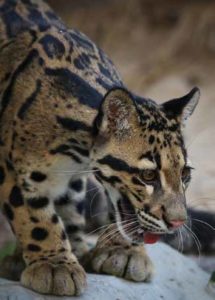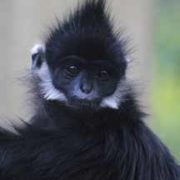WILDLIFE WONDERS NEW FOR THE NEW YEAR
by Tim L. Tetzlaff Naples Zoo Director of Conservation
I regularly take time here to write about how the support of our visitors, members, and donors enables Naples Zoo to care for wildlife around the world. At the same time, many of our on-site conservation programs are blended with those efforts to provide a hedge against extinction by breeding species outside the wild. A number of new arrivals as well as those coming in the next few months illustrate that work by our animal care staff in cooperation with other like-minded conservationists.
TIGERS ON THE MOVE
Naples Zoo is part of an international effort to insure Malayan tigers will be alive to see the 22nd century. The challenge is daunting and the risk is greater  than ever. The 20th century witnessed the loss of the Balinese, Javan, and Caspian tiger and the South China tiger is almost certainly extinct in the wild. During that same time, tiger populations plummeted from about 100,000 cats to a mere 4,000 tigers believed to survive in the wilds across all of Asia today. Of those, only 250 to 340 are the critically endangered Malayan tigers. Because their numbers continue to decline in the wild from poaching, habitat loss, and prey depletion, the Association of Zoos and Aquariums (AZA) manages a Species Survival Plan® (SSP) to protect these cats from extinction. Using carefully tracked lineages, the SSP coordinator makes breeding recommendations with a goal of maintaining healthy genetic integrity outside the wild for the next 100 years. Recently, Naples Zoo’s two brothers were matched with females to fulfill that mission and were moved to two other AZA-accredited zoos.
than ever. The 20th century witnessed the loss of the Balinese, Javan, and Caspian tiger and the South China tiger is almost certainly extinct in the wild. During that same time, tiger populations plummeted from about 100,000 cats to a mere 4,000 tigers believed to survive in the wilds across all of Asia today. Of those, only 250 to 340 are the critically endangered Malayan tigers. Because their numbers continue to decline in the wild from poaching, habitat loss, and prey depletion, the Association of Zoos and Aquariums (AZA) manages a Species Survival Plan® (SSP) to protect these cats from extinction. Using carefully tracked lineages, the SSP coordinator makes breeding recommendations with a goal of maintaining healthy genetic integrity outside the wild for the next 100 years. Recently, Naples Zoo’s two brothers were matched with females to fulfill that mission and were moved to two other AZA-accredited zoos.
Taking their place is another set of Malayan tiger brothers. Just over two-years old, these subadult cats can now be seen stalking through the bamboo or splashing in the pool in the Tiger Forest exhibit. Already over 200 pounds, they are growing up fast and will one day also play a role in saving their species.
LEOPARDS OF A DIFFERENT SPOT
 Other feline arrivals you can look forward to seeing in the New Year are a pair of clouded leopards, named for their beautiful cloud-like spots. Although still juveniles, they are designated as a mated pair and have an SSP breeding recommendation for the future as this species is vulnerable to extinction in the wild. The new clouded leopards will be taking turns with our older spotted leopard in a renovated exhibit. Less than half the size of these larger cousins, clouded leopards have the distinction of having the longest canines for their body size of any cat – about the same length as cats many times their size. These Asian
Other feline arrivals you can look forward to seeing in the New Year are a pair of clouded leopards, named for their beautiful cloud-like spots. Although still juveniles, they are designated as a mated pair and have an SSP breeding recommendation for the future as this species is vulnerable to extinction in the wild. The new clouded leopards will be taking turns with our older spotted leopard in a renovated exhibit. Less than half the size of these larger cousins, clouded leopards have the distinction of having the longest canines for their body size of any cat – about the same length as cats many times their size. These Asian
felines are wonderfully agile in trees aided by a long, heavy tail for balance. They can climb upside down like a sloth and even use their flexible ankle joints to hang by their back legs.
GROWING GREATER
Two other new animals will also be fun to watch grow up: Greater kudus. Less than two years old, these young antelope are just beginning to grow their horns. If you visited Naples Zoo in recent years, you saw the oldest recorded Greater kudu in North America and his magnificent spiral horns. With these new arrivals coming in 2017, you’ll be able to reset the clock and watch as their horns grow and begin their corkscrew turns reaching four to five feet in length.
LEAFS AND LANGURS
Over the last year, we’ve had some changes on the islands of the Primate Expedition Cruise and more are on the way. Keep an eye out for a new troop of monkeys called Francois’ langurs. These unusual looking monkeys with black hair and white side burns have an even more unusual stomach as it has two parts. Why? They eat leaves and that specialized stomach enables them to break down the cellulose that would pass undigested in our own stomachs as fiber. Sadly it’s the stomachs of humans that remain one of their biggest threats. In Vietnam and China, this endangered species is hunted to serve as a delicacy in Chinese restaurants and to make a traditional elixir called “black ape wine.” Here in Naples, we’ll be caring for a group of males. Like the tigers, we’ll provide a home for these bachelors until the SSP coordinator makes a breeding recommendation for these rare monkeys. I hope you’ll join us in our excitement for these new arrivals. And if you’re interested in supporting our conservation and education mission while bringing the kids or grandkids to see the animals grow up, we offer Zoo Memberships at different levels and benefits to enjoy yourself or to give to loved ones. (www.napleszoo.org/member) As a private nonprofit charitable organization, we depend on people like you to fulfill our conservation and education mission. On behalf of all the staff and animals at the Zoo, best wishes for the holiday season and a very Happy New Year!
Far from the simple menageries of the past, today’s nationally accredited zoos are centers of learning and natural crossroads for biologists, educators, environmental scientists, and researchers – as well as for students, conservationists, and all animal lovers. Naples Zoo at Caribbean Gardens is an award-winning, private 501(c)(3) nonprofit serving wildlife and families here and around the world. More information at www.napleszoo.org.




Leave a Reply
Want to join the discussion?Feel free to contribute!